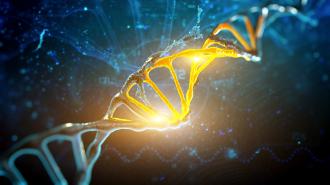As advances in medicine and technology continue to make our lives safer and more comfortable than ever before in human history, it might be tempting to believe that the evolution of our species has reached the end of the line.
In reality, this is far from the truth.
In nature, the energy that drives evolution forward comes in the form of glitches in the genetic information inherited by new generations. In humans, parents pass their genetic information along to kids inside one half of 23 pairs of chromosomes – but the process is never flawless.
Occasionally, random DNA changes between generations can provide some clear advantage.
As genes are handed down, their DNA may randomly change — accidental deletions, duplications, insertions, or transformations. The result is sometimes de novo genes, containing entirely new information that wasn’t inherited from either parent.
Most of the time, these mistakes won’t cause any discernible changes to a species’ characteristics; the changes that do can be harmful. Occasionally, however, they can provide some clear advantage, enabling individuals to survive and reproduce more readily. If they are successful enough, these new sequences may eventually spread to become the most common version of the gene.
This process is no less relevant to humans than any other species in nature, but since our species is such an evolutionary newcomer, the extent of its influence — and how it might work today — is still difficult to pin down.
The challenge: A team of researchers in Greece and Ireland, led by Nikolaos Vakirlis at the Alexander Fleming Biomedical Sciences Research Center in Athens, argues that a key to understanding human evolution lies with short sequences of DNA named “open reading frames” (ORFs). These structures are small sections of the genome that encode tiny protein molecules — microproteins — which can perform a diverse range of crucial biological tasks, from regulating muscle performance to alerting cells to damaging stresses.
Due to their minuscule sizes, ORFs are notoriously difficult to study. Because of this, their full relevance has gone under the radar in mainstream genomics research until recently, and even today, they still aren’t considered to be proper genes in themselves. For Vakirlis’ team, this potential oversight masks the fact that the microproteins encoded by ORFs can develop their own de novo sequences over generations, which may eventually develop into new genes.
Two of the microproteins were entirely unique to humans, emerging after our ancestors split away from chimpanzees.
Searching sequences: In their study, Vakirlis’ team developed an advanced new analytical technique that allowed them to thoroughly comb through recently published data on human microproteins. In particular, they hoped to identify and examine cases where our ORF microproteins have evolved into de novo sequences that hadn’t previously encoded genetic information.
In total, the researchers picked out some 155 de novo microproteins in the dataset. Having identified these molecules, they next aimed to determine when over the course of human evolution they first appeared, and predict the biochemical mechanisms associated with them.
Out of these new microproteins, two were entirely unique to humans, and emerged only after our ancestors split away from chimpanzees, between 5 and 7 million years ago. Equally relevant were other microproteins associated with certain genetic mutations, known to cause diseases in humans.
New microproteins: Vakirlis and his colleagues also showed that many of the microproteins they detected would have been invisible to more traditional analytical methods. This highlighted the fact that their own methods are likely still far from exhaustive, and that many more de novo microproteins could still be awaiting discovery.
If so, these molecules may well be the early stages of becoming proper genes, which could one day be encoded into the human genome and determine the evolutionary future of our species. In their upcoming research, Vakirlis’ team will aim to detect these more elusive sequences by refining their techniques further, and studying larger datasets of human microproteins.
The molecules may lead to new medical discoveries in the shorter term.
Evolution carries on: By drawing more attention to the relevance of ORFs and their de novo encoded microproteins, the team hopes that research into these important structures will soon become far more prevalent in mainstream genomics.
Altogether, their results paint a compelling picture of the nature of human evolution: far from slowing down since our species first emerged, changes to our genetic code continue to keep pace with the rest of nature.
While identifying and studying these molecules in more detail could offer new clues as to where our evolution may be headed in the future, they may also lead to new medical discoveries in the shorter term. By identifying how novel ORF mutations can disrupt the body’s biochemistry, researchers could soon develop new ways to diagnose and treat dangerous genetic diseases.
We’d love to hear from you! If you have a comment about this article or if you have a tip for a future Freethink story, please email us at tips@freethink.com.
